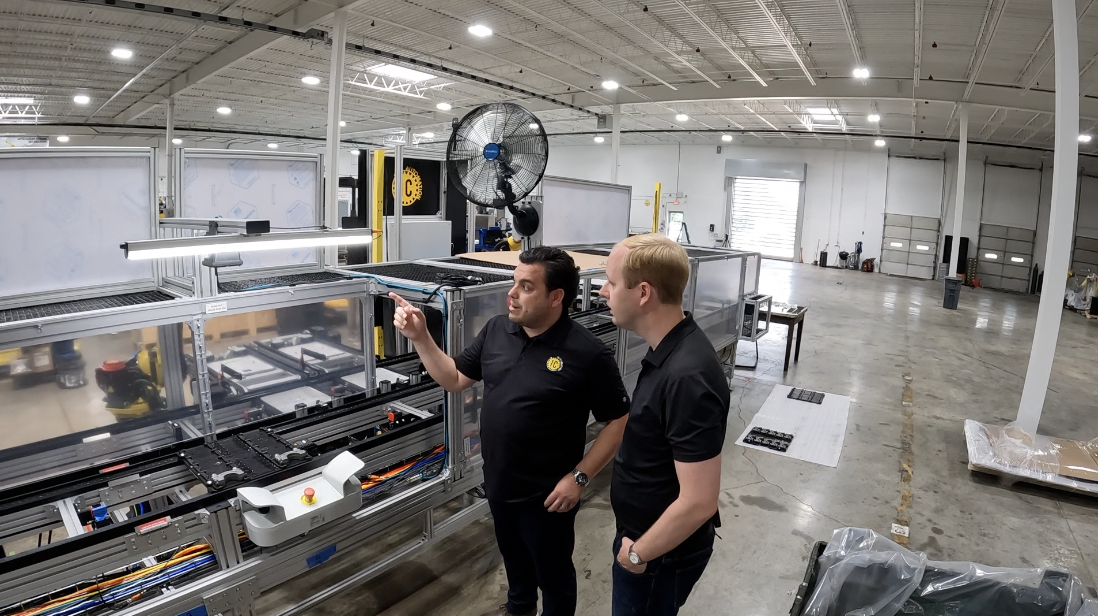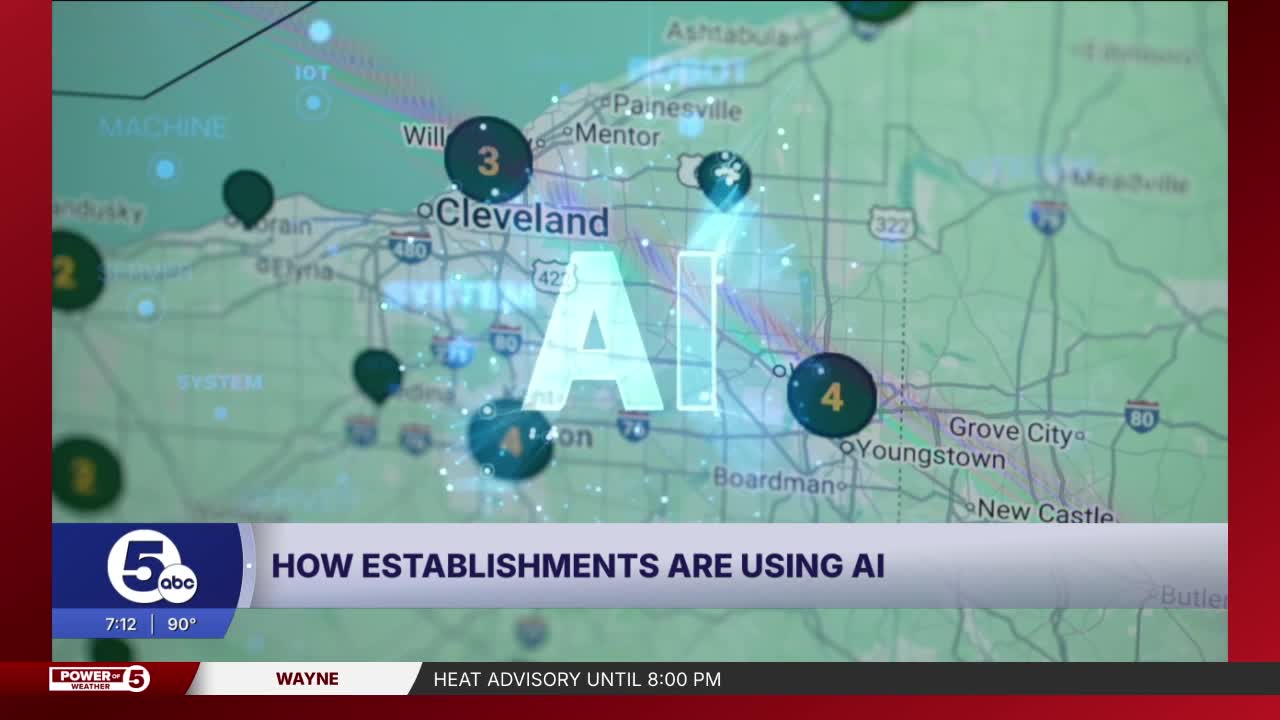CLEVELAND — From real estate to police and more, artificial intelligence is being integrated into established entities and companies across Northeast Ohio.
News 5 visited with several companies to see exactly how they're using it, and how they're not.
Real Estate
"It is amazing in the last 18 months how much we're using different forms of AI and where we think it's going," Hoby Hanna, CEO at Howard Hanna, told News 5.
Over the course of 68 years, Howard Hanna built a real estate empire.
Hanna detailed how it feels like they’re at another inflection point, similar to 1994, when they were one of the first real estate companies to highlight their homes on the World Wide Web.

“If you look at core businesses, some old traditional businesses like real estate or banking or the legal profession, I do really think AI is going to make the world more efficient, make the process of home ownership more efficient,” Hanna said. "I think 10 years from now, it'll be ubiquitous to everything we do."
A major area where he's already instituting changes is how people search for home listings online, switching from a checklist style of search to a search bar where buyers can communicate with AI and write what they're looking for. Additionally, AI will be able to better suggest home options based on prior search history.
"Most people go to websites and you search by bedrooms, bath and school district no matter what website it is," Hanna said. "We're going to develop something that searches more to how the consumer likes to look. [For example,] I want Brecksville with a big backyard fenced in and a pool. That's more than just Brecksville with 4 bedrooms."
Additionally, he's looking at how home suggestions can be better presented to buyers, similar to how Netflix suggests shows to watch based on prior history.
Beyond that, Hanna told News 5 that eventually AI could scrape online data to find telltale signs that someone is about to sell a home, such as estate sale listings, moving container rentals, and the amount of time spent in a home.
As for the future of real estate agents, Hanna says they’re safe.
"If I'm leery about it in any sense, is we still have to remember it's not human," he said. "When you're talking about most people's home that they're buying and selling, it's their castle. You need that human touch in that real estate agent, but I think it's gonna create an efficiency for real estate agents. It'll probably create new jobs and probably new opportunities and new industry 25 years from now that won't be the same as today, but an agent, I think is still such a central part of the process of purchasing the home.”
Police & Fire
Beginning Friday, many police departments and fire departments across Summit County will start using artificial intelligence around the clock to answer and field calls to their non-emergency lines.
Municipalities that currently utilize the Summit Emergency Communications Center are set to make the switch, which includes 11 police departments and eight fire departments, such as Cuyahoga Falls, Tallmadge, Stow, Silver Lake, Mogadore, Copley, Coventry Township, Munroe Falls, the Summit County Sheriff's Office and Summit Metro Parks.
Right now, AI is being used for about 16 hours a day. A phone call to Stow's Police Department between the hours of 7 p.m. - 11 a.m. currently involves a caller being greeted by "Ava," an AI created by the company Aurelian, saying, "Stow Police's non emergency line. My name is Ava. How can I help you?"

Ava collects the caller's information, analyzes it, and in some cases helps directly or passes along that information to dispatchers and police.
Friday's switch would make the non-emergency line driven by AI 24/7.
David O'Neal, director of the Summit Emergency Communications Center, estimates that across all their municipalities, they receive about 20,000-25,000 non-emergency calls a month. He is quick to point out that AI will not be used for anyone who calls 911, which will still be handled by a human dispatcher.
O’Neal hopes that people interact with Ava in a way they would not with a required automated call screener.
“I would like to think that this is a little more intuitive,” O’Neal said. “The biggest problem we have is callers call in and they want to talk to it like it's a robot. What we need them to do or what we hope they do is to call in and just talk to them like they're talking to a person. When the conversation gets choppy and you're using short words and short phrases with the system, it doesn't turn out as well.”
After completing a conversation with Ava, O'Neal said that the information is put in a queue to be analyzed by dispatchers, followed up with a text back to the person who called, telling them that their call has been reviewed and an officer will be responding shortly.
In some instances, O'Neal says the AI will trigger immediate human intervention.
“There's a bunch of keywords because people do call the non-emergency line when there's an emergency and so the system is trained to pick up on different keywords,” he said. “As soon as it hears those words, it says ‘stand by, I'm going to transfer you over to a dispatcher.’ It can also sense emotion. So if, if somebody's agitated when they call, the system can sense that, and sometimes it'll kick it over to a live person just because of how the person presents on the phone.”
O'Neal told News 5 that for every 911 call they receive at the dispatch center, they receive six calls to the non-emergency line, many of which he says do not require a real person, such as being transferred to a department or wanting a tow report.
“The idea is if we can take those non-emergency calls off of the call takers, they have the ability then to focus on the emergency calls that are coming in," he explained.
Manufacturing
Efficiency is key to Ivica Cacic at IC Automation in Solon. This equipment manufacturer modernizes the assembly line with his army of robots far beyond what Henry Ford’s eyes could imagine.
"Technology has come such a long way over the last 10 years, let alone over the past 100 years when Henry Ford started," Cacic said.
Cacic told News 5 how the company has been incorporating AI into its products for years, long before it became the buzzword it is today.
That includes using AI to build digital designs and test out products or integrating software into its assembly line to detect if a part doesn’t look just right, so it can be flagged, removed or even adjusted so it doesn’t slow down production.

"It's critical," he said. "So you know when you get into certain cycle times, you can be able to pick, you're putting seconds or microseconds on things that used to take a minute to do.
The company makes machinery for various companies in all sorts of industries, including automotive, firearms and other specialized parts. Speeding up the process and shifting what employees focus on.
"We call it intelligent advanced manufacturing," he said. "This cell here would be operated probably by between 12-18 people, but this really enables them to be competitive on a global scale where they'll have five people operating a part and they'll be able to make many more parts with this system here."
Cacic told News 5 that he has seen the evolution of AI learning, but admits that there's still some teaching left to be done.
“It's thinking about what's the best way to do what I need to do and the most efficient way to get there," he said. "[AI is] real and it's here to stay. It's only gonna grow."
Clay LePard is a special projects reporter at News 5 Cleveland. Follow him on Twitter @ClayLePard, on Facebook Clay LePard News 5 or email him at Clay.LePard@WEWS.com.
Download the News 5 Cleveland app now for more stories from us, plus alerts on major news, the latest weather forecast, traffic information and much more. Download now on your Apple device here, and your Android device here.
You can also catch News 5 Cleveland on Roku, Apple TV, Amazon Fire TV, YouTube TV, DIRECTV NOW, Hulu Live and more. We're also on Amazon Alexa devices. Learn more about our streaming options here.





